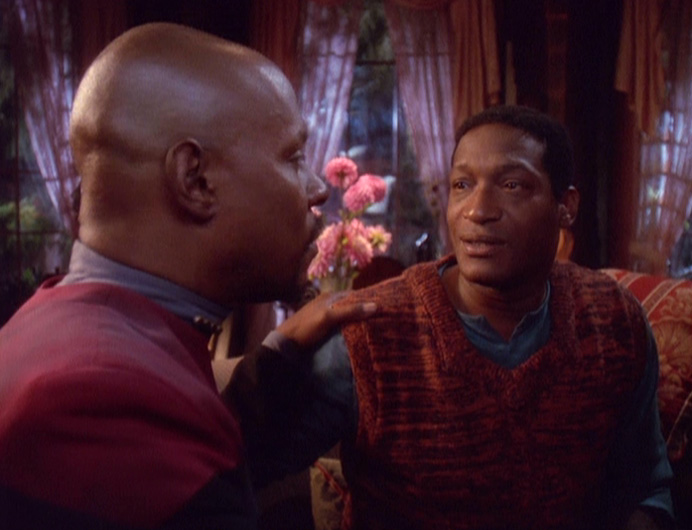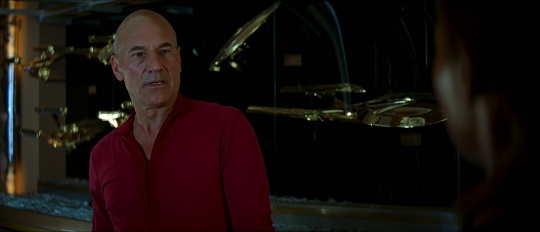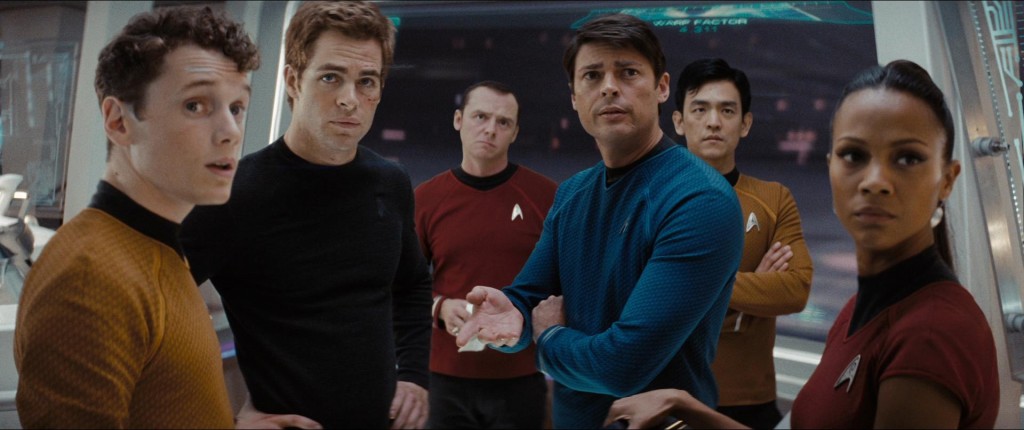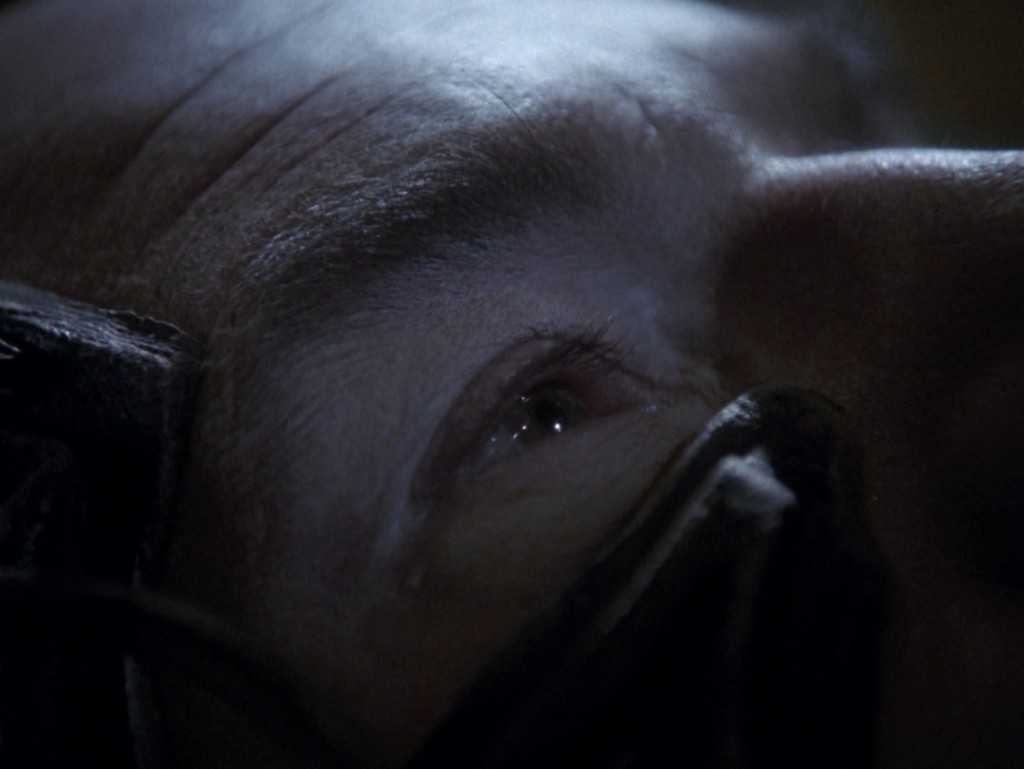On September 8th, 2016, the Star Trek franchise will officially turn 50, and what better way to celebrate than to count down the 50 greatest Star Trek stories in the canon? Deadshirt Founder and Editor Emeritus Dylan Roth pored through the 728 episodes and films to select the Top 50 Star Trek Voyages.
#15: “Chain of Command”
Star Trek: The Next Generation
Season Six, Episodes Ten and Eleven
Originally aired December 14th & 21st, 1992
Story by Frank Abatemarco
Teleplay by Ronald D. Moore (pt.1) & Frank Abatemarco (pt. 2)
Directed by Robert Sheerer (pt. 1) & Les Landau (pt. 2)
When Gene Roddenberry created The Next Generation, he was adamant that the ship’s crew—and humans in general—not be in conflict with each other. He felt that, in the future of Star Trek, humanity would have evolved past petty differences and be able to nip any interpersonal issues in the bud. This led to some interpersonal issues amongst the show’s writers, who struggled with the prospect of writing a weekly ensemble television show in which the ensemble always gets along and all conflict must come from outside forces. After Gene’s death, Executive Producer Rick Berman gave into the writing staff’s demands and started allowing more tension aboard the Enterprise, and this two-part episode, “Chain of Command,” highlights the importance of that decision.
In “Chain of Command,” Captain Picard is reassigned to a covert mission in Cardassian space and is quickly and quietly replaced by Captain Edward Jellico (Ronny Cox). Jellico immediately begins instituting huge changes to the way the Enterprise operates, which frustrates the crew, who have served under Picard for over five years and liked things the way they were. Jellico isn’t evil or incompetent, he’s just different, and he and the series regulars (particularly Commander Riker) don’t get along. Characters + Conflict = Story.
And that’s just the engine behind Part One. The real beauty of “Chain of Command” comes in Part Two, in which Picard, captured during the previous episode’s black op, is held prisoner by a cold but brilliant Cardassian interrogator (David Warner). Their scenes are almost exclusively one-on-one dialogues, as Picard attempts to maintain his will and his sanity through Gul Madred’s torture. In addition to a gut-wrenching, brilliantly acted commentary on the cruel pointlessness of torture, it’s a character study that digs deep into both the guest star and the series lead.
#14: “The Visitor”
Star Trek: Deep Space Nine
Season Four, Episode Two
Originally aired October 9th, 1995
Written by Michael Taylor
Directed by David Livingston
After the negative fan response to Wesley Crusher, having a teenaged boy on the cast of Deep Space Nine was a risky move. It makes much better story sense here—Jake Sisko isn’t a young genius or an Academy candidate, and he’s very rarely involved in the main plot of the episode. Jake never saves the station, in fact he’s mostly around to create problems, or to act as a foil for his father. Jake’s presence on the show contributes to making DS9 feel like a small town, and offers a window into stories that don’t involve Starfleet or life-and-death struggles. But Jake himself, he’s kind of lame.
When you cast a child actor as a series regular, you’re betting heavy that this kid is going to grow up into a strong adult actor who can get more interesting and more challenging stories later on. Some shows get lucky—Mad Men cast Kiernan Shipka when she was seven and by the final season she was one of the finest performers on the show, capable of carrying a lot of narrative weight. DS9 cast thirteen-year-old Cirroc Lofton as Jake, and, well, they were less lucky. The older Lofton got, the more clear it became that this was not a future Emmy-winner, and as a result, Jake did not get better stories as he grew up. Mostly, he’s just there. But there is one great Jake story, and it’s made possible by replacing him with a much better actor for most of the episode.
“The Visitor” opens on Earth, with a young aspiring writer arriving unannounced at the door of her favorite author: Jake Sisko, now an old man portrayed by Tony Todd in heavy makeup. Jake tells the young woman the story of why, after publishing a single acclaimed novel, he stopped writing. In Jake’s narrated flashback, we return to the present of the show. There, he witnesses Captain Sisko vanish in a freak accident involving a recurring spatial phenomenon. Initially presuming him dead, Jake learns that he is dragging his father with him through time, as Ben reappears in Jake’s life for a few minutes at a time, years or even decades apart. Unable to grieve for a father that’s not really gone, Jake becomes obsessed with bringing his father back to life permanently, but the effort costs him his career and his chance at a family. Each time he visits, Ben urges his son to move on and live his own life, but poor broken Jake just can’t get over it.
For most of the story, Jake is portrayed by Tony Todd, as he grows into an adult and eventually an old man, aging past Captain Sisko, who remains the same. Each interaction feels more and more tragic, with Ben losing years of his son’s life, and Jake losing everything for one shot at setting things right and saving them both. The final act of “The Visitor” is a gut punch that no amount of time travel can totally heal, and is well known for reducing viewers to puddles. Most of the credit goes to Todd and Avery Brooks, but Dennis McCarthy’s score pulls a lot of emotional weight as well.
Is it fair that the best Jake story doesn’t heavily feature Cirroc Lofton? Perhaps not. But given the result, it’s hard to imagine this episode being as powerful any other way.
#13: Star Trek: First Contact
Originally released November 22nd, 1996
Story by Rick Berman, Brannon Braga, & Ronald D. Moore
Screenplay by Brannon Braga & Ronald D. Moore
Directed by Jonathan Frakes
“They invade our space, and we fall back. They assimilate entire worlds, and we fall back. No more. The line must be drawn here! This far, no further. And I will make them pay for what they’ve done!”
Since they were first introduced in the Season Two TNG episode “Q Who?”, the Borg have become one of the most iconic villains in science fiction. “Resistance is Futile” is part of our cultural lexicon, to the point of being used in a marketing campaign for Auntie Anne’s pretzels a decade after the Borg made their final on-screen appearance. So it stands to reason that, particularly after the stutter-start that was Star Trek: Generations, Rick Berman and company would want to showcase them in a feature film.
First Contact pits Picard and the shiny new Enterprise-E against another Borg invasion, but this time the cybernetic baddies have a backup plan. When their ship is destroyed in Earth orbit, a small support craft appears to try again when humanity is more vulnerable: the past! The Enterprise alone manages to follow the Borg back to the mid-21st Century—on the eve of humanity’s first warp flight and first contact with alien life—to prevent them from turning all of Earth into another hive of Borg drones. The conflict has Picard going head-to-head against the Borg Queen (Alice Krige), the being responsible for his kidnapping and assimilation years earlier.
First Contact is arguably the earliest Trek feature to aim at being an action movie. Dark, scary, and violent, the film pushed the boundaries of the franchise’s famous optimism, and saw Captain Picard lose himself in a quest for revenge against the beast that wounded him back in the famous “Best of Both Worlds” two-parter. While Picard is accustomed to being the one giving the stirring speech about ethics and morality, this time it’s 21st century engineer Lily Sloane (Alfre Woodard) who must serve as his conscience, and the two play off each other brilliantly.
The moody story aboard the ship is contrasted by the admittedly goofy B-plot occurring on Earth, in which Riker and Troi must keep the drunken letch Zephram Cochrane (James Cromwell) in line long enough to conduct his historic warp flight. The comedy doesn’t always land particularly well, but Cochrane’s story is the soul of the film. Before making first contact with extraterrestrials, humanity is still fragmented, greedy, and kind of stupid, and that’s Zephram Cochrane. Understanding that humans aren’t alone in the universe is going to change all that, and Cochrane is our lens into the the way the world is going to change. The Borg are trying to prevent first contact and deny humanity the bright future that the show is all about. What’s on the line is Star Trek itself.
Plot holes abound in First Contact, but it’s full of fun and thoughtful moments, and the action and effects hold up really well. Before the 2009 reboot, if you needed to introduce a young person to Star Trek, this was your gateway.
Further Viewing: First Contact kicks off a time paradox that is followed up in the Enterprise episode “Regeneration.” The episode is not particularly good, but it does close a loop that “began” back in early TNG when the Borg first start poking into Federation space.
#12: Star Trek
Originally released May 8th, 2009 (USA)
Written by Alex Kurtzman & Roberto Orci
Directed by J.J. Abrams
A time-traveling madman alters history, creating a new reality where young James T. Kirk is a damaged misfit wasting away in Iowa instead of fulfilling his first, best destiny of starship command. But with the help of mentor Christopher Pike, Academy classmates McCoy & Uhura, and a version of Spock from the future, Kirk embarks on a mission to save the Federation—not to repair the timeline, but to embark on a bold new adventure.
“This is not your father’s Star Trek,” boasted one TV commercial.
“Fuck you,” replied legions of lifelong Trekkers. How dare Paramount reboot a famously brainy science fiction series as a big, loud action movie? How dare they throw away four decades of established continuity? And to top it all off, they hire a director who would clearly rather be making a Star Wars movie! This was going to be a disaster.
“Eat my shorts,” said Paramount. And thank goodness they did. For twenty years, Star Trek had felt more or less unchanged. Yes, there were peaks and valleys in quality, but the emotional tenor of the series remained fairly consistent. High sci-fi concepts, low emotional stakes. Stage-y acting and unambitious cinematography. Dry conversations across a conference table. The 2009 Star Trek may have overcompensated a bit (lens flares, lots of running and screaming), but delivered something that the franchise had arguably never produced: an emotional roller coaster. And it did all of this without compromising Star Trek’s crucial message of peace, friendship, and curiosity.
Some may call it fixing what ain’t broke. I call it “going boldly.”
#11: “The Best of Both Worlds”
Star Trek: The Next Generation
Season Three, Episode Twenty-Six; and Season Four, Episode One
Originally aired June 18th and September 24th, 1990
Written by Michael Piller
Directed by Cliff Bole
What’s left to say about the episode that put The Next Generation on the map? Quite a lot, actually—it’s the subject of this full-length review. But here, I’ll simply say that no single television story has had as tremendous an impact on Star Trek, as a universe or as a franchise, as “The Best of Both Worlds.” There’s a reason it’s as acclaimed and iconic as it is. Part One “TBoBW” is one of the best performed, best produced, best written, best scored hours of television ever, and if the second half measured up, the story as a whole would probably have landed not just in the top ten, but in the top five. Even if the conclusion doesn’t quite live up to the legendary cliffhanger, it’s still an incredible two-parter. Check out the full review to explore just how much this story holds up.
#10-6 Next Monday: Life, Death, Rebirth, & the Prime Directive.






